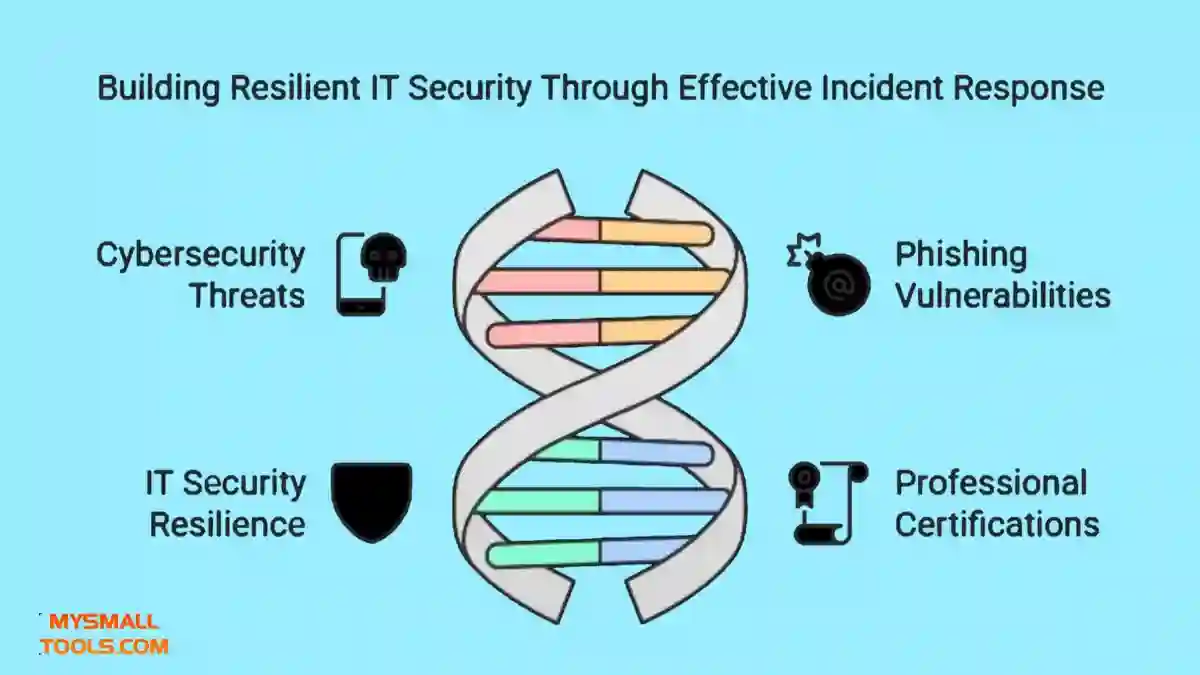In the contemporary digital landscape, companies are continually challenged by cybersecurity threats, particularly as criminals take advantage of vulnerabilities associated with phishing. Establishing a robust strategy for incident response and recovery is essential for protecting the organization and enhancing its IT security resilience.

Certifications such as CompTIA Security+ equip professionals tasked with providing defense against cyber threats.
Comprehending Incident Response
To effectively handle the lifecycle of incident response—which encompasses identifying, responding to, and rectifying cybersecurity events like data breaches, malware issues, and threats from insiders—organizations must have a comprehensive understanding. Having well-defined protocols for rapid and accurate action significantly mitigates long-term operational impacts on both business operations and financial performance.
Essential Stages of Incident Response
Incident response constitutes a multi-stage approach including preparation, detection, containment, eradication, recovery, and learning from the experience.
Preparation: This stage involves readying personnel through training and ensuring all essential tools and resources are available to manage potential incidents effectively.
Detection: Organizations need to quickly identify incidents through monitoring network traffic and logs, employing advanced technologies to uncover threats and prevent breaches.
Also Read
Containment: When an incident is identified, swift measures must be taken to control the circumstances and avert any further development.
Eradication: After containment, efforts should focus on eliminating the source of the attack across affected systems, including the removal of harmful files and addressing vulnerabilities.
What Constitutes an Incident Response Plan?
An Incident Response Plan equips an organization to react appropriately to security breaches or cyberattacks. This plan delineates the actions an organization must undertake upon detecting a potential cyber threat, enabling them to swiftly identify, contain, and resolve issues. Moreover, it’s critical for organizations to establish procedures for reporting cyber incidents.
Why Is an Incident Response Plan Essential for Businesses?
Organizations require an Incident Response Plan to safeguard their data, networks, and services against malicious actions while ensuring their employees are prepared to respond effectively. A robust incident response strategy allows firms to quickly detect and tackle cyber threats, reduce the fallout from such threats, and preserve the integrity of compromised systems.
Additionally, possessing an incident response plan signals a business’s commitment to cybersecurity and the impact it has on its employees, customers, and suppliers.
The Significance of Incident Response Planning
Planning for incident response is vital in the current digital environment, where cyber threats are increasingly prevalent and advanced. A well-structured incident response plan enables organizations to lessen both the time and impact of security incidents, enhance recovery times, diminish adverse attention, and establish effective practices for managing incidents.
Reducing the impact and duration of security breaches is critical for organizations. A well-designed incident response strategy enables organizations to quickly recognize, manage, and resolve security breaches.
Taking this proactive approach helps to stop the situation from escalating and inflicting more damage. By limiting the duration of security events, organizations can substantially lessen financial losses, damage to their reputation, and the risk of legal repercussions.
Advantages of Having an Incident Response Plan
An Incident Response Plan (IRP) is essential for any effective strategy aimed at preventing cybercrime. It specifies the crucial actions and protocols that an organization needs to follow when a cybersecurity incident occurs.
The implementation of an IRP presents five key advantages that help mitigate the effects of cyberattacks and enhance the organization’s defenses against digital threats. A thoughtfully crafted IRP enables swift identification, containment, and resolution of cybersecurity issues. Furthermore, it assists organizations in:
- Reducing both downtime and financial losses.
- Rapidly evaluating the repercussions of cyber threats and enacting necessary measures.
- Determining the origin of an attack is crucial in order to avoid similar events from occurring again down the line.
- Restoring regular operations and safeguarding data from further loss or exploitation.
- Strengthening cybersecurity posture and ensuring compliance.
- Enhancing user awareness regarding cyber threats and response strategies.
- Signifying that a business is committed to its cybersecurity efforts.
The Importance of Recovery in IT Security
While incident response is vital for managing cyberattacks, recovery plays a crucial role in ensuring lasting stability. Recovery entails reinstating data, systems, and overall business operations to their state prior to the attack, thereby enhancing security measures.
The most successful methods for recovery include regular backups, comprehensive disaster recovery plans, and thorough business continuity strategies. Companies that depend on digital infrastructure may face substantial monetary losses and harm to their image due to interruptions in operations.
Advantages of Effective Incident Response and Recovery
Creating a well-defined strategy for incident response and recovery offers a variety of advantages:
Minimizing Downtime: An effective response strategy reduces downtime, allowing businesses to return to usual operations swiftly after an incident.
Reducing Financial Losses: Organizations that can swiftly recover and adapt to new instances of cyber attacks will curtail financial losses associated with data breaches and system failures.
Safeguarding Sensitive Data: The incident response helps protect sensitive information, minimizing the risk of data loss during a cyberattack.
Enhancing Security Posture: Each incident provides valuable insights into vulnerabilities within an organization, facilitating the implementation of layered security measures over time.
The Importance of CompTIA Cybersecurity Professionals
The influence of CompTIA certifications on incident response and recovery is significant for security professionals. IT security personnel holding a CompTIA Security+ certification are well-equipped to handle cybersecurity incidents.
Certified professionals in CompTIA Security+ are grounded in key concepts such as risk management, cryptography, and identity management, enabling them to confront threats effectively. They can develop reactive incident response strategies and oversee recovery efforts by ensuring data integrity, restoring systems, and reinstating security measures.
In Summary
The management of incidents and recovery is vital within an organization’s IT security strategy. Without a robust plan in place, organizations are vulnerable to severe damage from cyberattacks.
By integrating a well-structured incident response framework with the expertise of CompTIA-certified cybersecurity professionals, organizations can limit the impact of attacks, protect sensitive information, and foster trust with their clientele.


